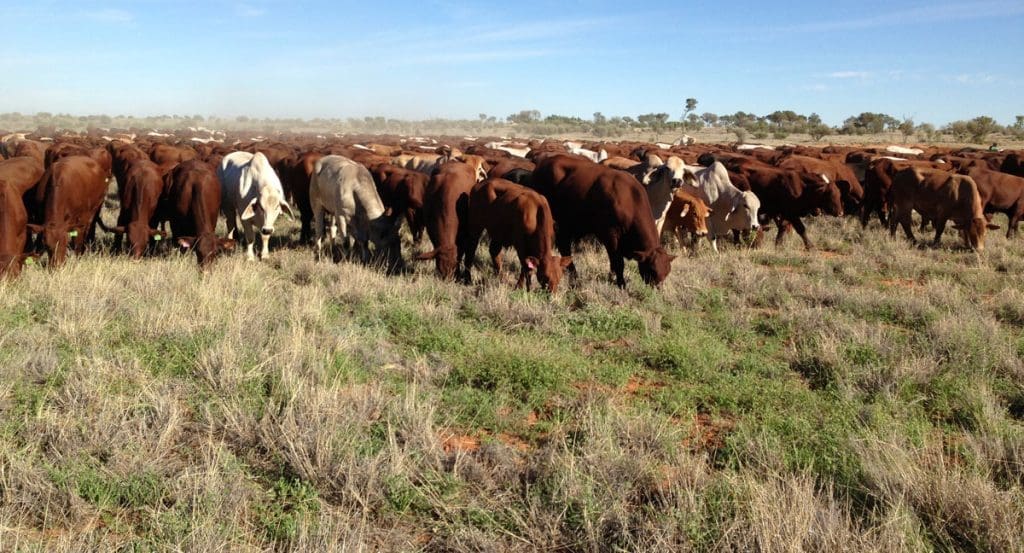
Grass steers on Kidman’s Naryilco in the Channel Country
ONCE upon a time, the annual ‘Channel Country bullock turnoff’ was an absolute curve-bender in the northern and eastern Australian slaughter cattle market environment.
Very large, even lines of heavyweight grassfed bullocks off the Diamantina, Georgina and Cooper systems would head east or south each year during spring, having gorged themselves on the region’s ‘grass feedlot’ resource of native sorghum and other nutritious grasses.
And it couldn’t happen at a better time, given that August-September is typically the tightest month of the year for northern processor cattle supply.
The channels region provided a supply backbone for many Queensland and some southern beef processors, either by road or rail, for several months heading towards summer.
But not any more.
The Channel Country’s vast feed resources are now largely devoted to pursuits other than generic grassfed bullock production. Some has gone into Certified Organic programs. Some has been converted into backgrounding roles, or even used for breeding Wagyu and other types.
The days of Stanbroke, AA Co or NapCo marketing 360kg dressed weight channel country grass ox in their tens of thousands each spring are now long gone.
On the flipside, it can be argued that more of those former ‘grass bullocks’ are now appearing in processors’ kill rosters as grainfed steers, having finished their last 100-150 days in the yard instead of on the channels, meaning they have not really been ‘lost’ to the processing system – just appearing under a different category.
Processors’ rosters now current
With August now arrived, Queensland processors are now more current for supply than they have been for some time – a typical August pattern.
Bookings are available at most sites for kills any time from mid-month.
One contact said a few Channel Country bullocks were ‘just starting to come,’ but nothing like the numbers seen in years gone by.
“The early shipments are showing the benefits of an exceptional year in the channels, season wise,” he said.
For that reason, the start of the channel country turnoff was coming a little earlier than normal this year – at least a month, the contact suggested.
Some of those cattle did not get out at the end of last year after it started to rain, meaning there were some carry-over cattle about, with some serious weight to them – at least high 300s.
But an earlier start to channel country turnoff this year due to high weightgain also meant an earlier finish, one Queensland processor pointed out.
“Supply from the region could start to run out of steam this year by October,” one contact said.
“But it’s a bit all over the shop this year, in terms of cattle supply outlook from the north and west. Second-round musters have been late in many areas of the northwest due to earlier unseasonal rain, which is pushing some deliveries back in the calendar.”
“And oats cattle (see today’s separate report) are rapidly running out of steam in some areas – it’s making it hard to get an accurate gauge on the slaughter cattle supply outlook for the next few months.”
“And a lot of light cattle went onto oats this year, destined for the feedlot, rather than being taken through to slaughter weights,” another processor said.
The international meat market remains listless this week, with flat demand across North and South Asia and North America due to cautionary consumer spending.
That’s pushed more export-type beef back onto the domestic market, with some absolute bargains evident in the domestic ‘warehouse retail’ style channel again this week in capital cities. More on that in a separate story to come.
Grid prices steady
There has been little to no change evident in direct consignment slaughter cattle price offers across eastern and southern Australia this week.
Following a rise of 5-10c/kg in many processor grid offerings last week – the first upwards movement all year for some – over the hooks quotes remain largely unchanged this morning.
Active quotes seen from large competitive processors in the concentrated southern Queensland region have four-tooth grassfed export ox at 530c/kg this week and cows 450c.
Processors in southern states were unchanged this morning, at around 555c/kg for grassfed four-tooth ox in South Australia and southern NSW, with cows at 450c/kg in competitive grids in both regions.
Softer trend in saleyards channel
In saleyards trading early this week across eastern Australia, there’s been a distinct dip in slaughter cattle prices, compared with early last week.
Gunnedah this morning yarded 3315 head, up 1165 due to deteriorating seasonal conditions. Medium to heavyweight yearling steers and well-finished grown heifers were 10-20c cheaper. There was also a cheaper trend through the cow market, back by up to 27c/kg.
Wodonga sale this morning attracted 1200 head, with price drops of 20-40c/kg common as the sale progressed. Heavy steers ‘lacked any urgency’ averaging 267c, with bullocks dipping 12c selling from 255-292c. Better finished cows were 30-40c cheaper in an erratic sale.
At Naracoorte this morning cows were firm to 5c dearer, while trade types were 5-10c cheaper.
- NLRS week slaughter summary will appear tomorrow, after the report is released
